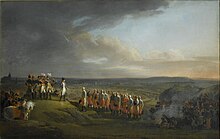| Battle of Ulm | |||||||||
|---|---|---|---|---|---|---|---|---|---|
| Part of the Ulm campaign during the War of the Third Coalition | |||||||||
 The Capitulation of Ulm, by Charles Thévenin | |||||||||
| |||||||||
| Belligerents | |||||||||
|
|
| ||||||||
| Commanders and leaders | |||||||||
|
|
| ||||||||
| Strength | |||||||||
| 80,000[1][2] | 40,000[1][3][4] | ||||||||
| Casualties and losses | |||||||||
| 1,500 killed, wounded or captured[5][6][7] |
4,000 killed or wounded 27,000 captured[5][6][7] | ||||||||
Location within Europe | |||||||||
War of the Third Coalition:
Austria
Austria
current battle
Napoleon in command
Napoleon not in command
The Battle of Ulm on 16–19 October 1805 was a series of skirmishes, at the end of the Ulm Campaign, which allowed Napoleon I to trap an entire Austrian army under the command of Karl Freiherr Mack von Leiberich with minimal losses and to force its surrender near Ulm in the Electorate of Bavaria.[8][9]
- ^ a b Fisher & Fremont-Barnes 2004, p. 41.
- ^ Maude 1912, pp. 43–73, Chapter II. The French Army.
- ^ Maude 1912, pp. 1–43, Chapter I. The Austrian Army.
- ^ Fisher & Fremont-Barnes 2004, p. 32.
- ^ a b Nafziger 2002, p. 282, Ulm, Capitulation of. (-U-).
- ^ a b Chandler 2009, p. 399, 35. Strategic Triumph-Ulm (Part Seven. From the Rhine to the Danube).
- ^ a b Maude 1912, pp. 252–264, Chapter IX. Conclusion.
- ^ Connelly 2012, pp. 118–141, 9. Subduing the European powers: Austerlitz – Jena-Auerstädt – Friedland, 1805–07.
- ^ Allsbrook, John T. Turin, Dustin (ed.). "Napoleon Bonaparte's Peak of Military Success: Ulm and Austerlitz". Inquiries Journal. 4 (9). Boston, Massachusetts, United States: Inquiries Journal/Student Pulse LLC/Northeastern University: 1–2. ISSN 2153-5760. Archived from the original on 6 October 2016.

